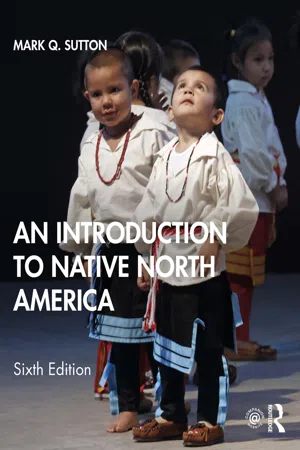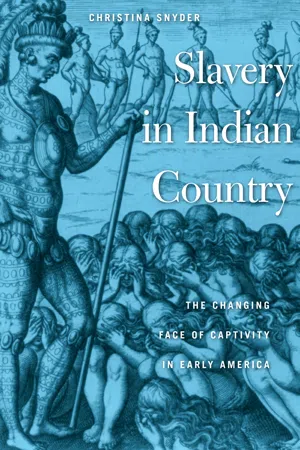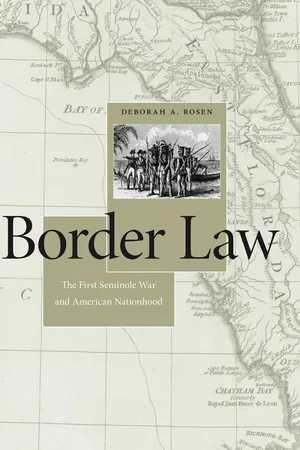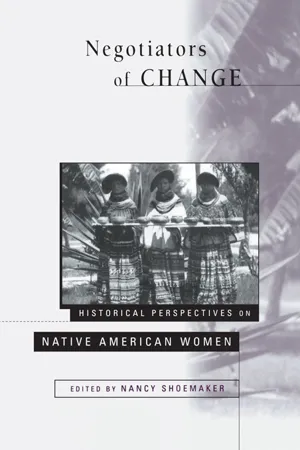History
Seminole
The Seminole are a Native American tribe originally from Florida. They are known for their resistance to colonization by the United States and their successful adaptation to the Everglades environment. The Seminole Wars, fought between the Seminole and the U.S. government, are a significant part of their history, as is their unique cultural heritage and traditions.
Written by Perlego with AI-assistance
Related key terms
1 of 5
7 Key excerpts on "Seminole"
- eBook - PDF
High Stakes
Florida Seminole Gaming and Sovereignty
- Jessica Cattelino(Author)
- 2008(Publication Date)
- Duke University Press Books(Publisher)
If it is restricted to a legal-political context, then it becomes a limiting concept which serves to prevent solutions” (V. Deloria 1979: 28). Seminole governance, as discussed throughout this book, shows sov-ereignty to be cultural, moral, and material, even as it is also a politico-FIgure 24. Happy Jones (Bird) teaches Brighton children about Seminole medicine plants, 2001. Photo by author. ChaP ter 4 10 legal status. When Max Osceola Jr. (Panther), the Hollywood Tribal Council representative, spoke of “self-determination,” he referred to indigenous control over life in its fullest: “not just government: culturally, socially, not just economics.” For him, governing meant the right to “make social decisions, cultural decisions: how to live.” He continued: “When I say gov-ern, I don’t mean it only in the sense of the federal government, of the senators and the congressman, but the right as the head of the house, or in your clan” (January 23, 2001). This sense of sovereignty is less juridical or recognition-based than it is a forward-looking political process geared toward the realization of collective political and social life. It is also notable for the purposes of this chapter that the clan and the household figure prominently in Osceola’s description of governing. It is to housing that we now turn, in order to look beyond the ideologies and administrative apparatuses of self-determination by examining its materiality. From ChICkees to ConCrete BloCk struCtures Housing is one among many domains in which casino wealth has enabled Seminoles to reorganize administrative relationships with important eco-nomic, social, and political consequences. - Available until 25 Jan |Learn more
- Mark Q. Sutton(Author)
- 2021(Publication Date)
- Routledge(Publisher)
www.census.gov/population/www/cen2010/cph-t/t-6tables/TABLE%20(1).pdf ), many living on four reservations in southern Florida. Hunting and fishing are still important for them, with seasonal labor from farm work and sales of Native crafts also bringing in some revenue.In 1979, the Florida Seminole opened a high-stakes bingo parlor on their reservation and set in motion a process that would lead to the establishment of casinos by Indian tribes across the United States (see Chapter 13 ; also see Pleasants 2010). The Seminole in Florida later opened casinos, gained considerable economic power (see Cattelino 2008), and, in 2006, purchased the Hard Rock brand (hotels, cafes, and casinos). The Seminole also permit Florida State University to use the “Seminole” as their athletic mascot (an exception to NCAA policy). One can visit the Florida Seminole at www.Seminoletribe.com and the Oklahoma Seminole at www.sno-nsn.gov .Many individual Southeastern Indians continue to live in their former homelands across the Southeast; however, only a few, such as the Eastern Cherokee and the Seminole, have reservations in the region. Some, such as the Waccamaw in North Carolina, “blended in” with the colonists very early but managed to maintain their Indian identities and were not removed to Oklahoma (Lerch 2004). The remainder of the removed groups now have formal land bases in Oklahoma.The Impact of European Contact
When the de Soto expedition made its way through the Southeast between 1539 and 1543, it made an immediate impact (see Milanich 1995; Worth 1998). First, the Spanish used military force to subdue some groups, whereas others that did not encounter the Spanish remained relatively unaffected. After the Spanish left the Southeast, groups that had been militarily weakened fell prey to their unaffected, and therefore stronger, enemies. An overall increase in Native warfare resulted, bringing with it the destruction of some groups by their Indian enemies and a realignment of regional politics. - eBook - ePub
Women, Power, and Ethnicity
Working Toward Reciprocal Empowerment
- Patricia S.E. Darlington, Becky Michele Mulvaney(Authors)
- 2014(Publication Date)
- Routledge(Publisher)
Native American Women and Power“Immigrants” in their Own Land: A Brief History of the Seminole Nation and its WomenAlthough we had originally intended to speak with women from two of the most well-known Native American tribes of contemporary South Florida—the Seminoles and the Miccosukees—we were granted access only to the Seminole reservation. Therefore, this chapter focuses on that Native American group. The original indigenous peoples of Florida were the Apalachee, the Timuccua, and the Calusa. According to Garbarino (1972), the Seminole Indians are a post-Columbian group whose name does not appear widely until 1750. They are descendants of the Yamassee of the Carolinas and the Oconee of Apalachicola. Kersey and Bannan (1995) explain that those people, who now make up the Seminole Nation, are actually descendants of the Creek Indians who left Georgia for Spanish-governed Florida in the 1700s.Due to historical circumstances, the Seminoles are rather like immigrants even though they are Native Americans. The Seminoles claim South and Central Florida as their current homeland primarily as a result of Andrew Jackson’s policy to move all Indians of the Southeast westward to Oklahoma. The Seminoles of Florida are those Native Americans who resisted Jackson’s policy by fleeing into the Everglades. As Garbarino (1972) explains, “The term ‘Seminole,’ indicating a social or political unit, was … applied to various people who were descendants of a number of different southeastern tribes which had mingled with one another and with the remains of the earlier Florida groups” (p. 9). When the United States acquired Florida in 1819 and began the process of taking what had been Seminole land and at the same time relocating Native Americans to reservations in Oklahoma, a minority escaped, resisting the U.S. government in a series of Seminole wars from the 1830s through the 1850s (Kersey and Bannan, 1995). - eBook - PDF
Slavery in Indian Country
The Changing Face of Captivity in Early America
- Christina Snyder(Author)
- 2010(Publication Date)
- Harvard University Press(Publisher)
The Seminoles, mean-while, clung fiercely to their decentralized form of government, purposeful isolation from American culture, and tributary social system. Both nations fought removal, but the Cherokees did so with legal battles and savvy di-plomacy, while the Seminoles used armed resistance. Seeking to overcome this difference, Ross revived the language of nativism, appealing to his S E M I N O L E S 242 fellow “red-man.” The delegation echoed Ross’s argument, “We stated to them that their Nation and the Cherokees, were now the only southern Indians east of the Mississippi river, and as brother Indians, we ought to settle our difficulties together with the United States, in a peaceable and friendly way.” 90 Some Seminoles distrusted the Cherokees from the start. Arpeika, a Mikasuki religious leader, refused to visit them, saying that he “was quite encensed [sic] against the deputation, and charged us with being leagued with the whites to deceive them.” Micanopy, Cloud, Nocose Yahola, and others, however, agreed to accompany the Cherokees to Fort Mellon for a talk with Thomas Jesup. Just as the Seminole leaders reached the fort, however, a runner delivered news: Coacoochee, a leading Seminole war-rior, had miraculously escaped from a St. Augustine prison. The runner rejoiced that his people “had determined to fight and die on the land that the Great Spirit had given them. ” 91 In a panic, U.S. officials seized and imprisoned the Seminole leaders, making it appear as though the Chero-kees had set a trap for them. 92 With slavehunting Creeks and seemingly conniving Cherokees about them, the Seminoles must have felt truly alienated— all the South’s free people, including their fellow Indians, seemed to be conspiring to expel them from the region. The United States failed in its mission to remove all Seminoles but suc-ceeded in producing a racial faultline that stressed Seminole society to the breaking point. - eBook - PDF
Border Law
The First Seminole War and American Nationhood
- Deborah A. Rosen(Author)
- 2015(Publication Date)
- Harvard University Press(Publisher)
c h a p t e r f o u r Creeks, Seminoles, and Indian Wars F rom the perspective of the United States, Creek and Seminole legal status differed significantly from that of Spain. Both international rules of war and domestic American legal principles applied differently to indige-nous people than to Europeans. Consequently, the United States argued, its legal obligations to Florida Indians in the Seminole War were quite unlike its lawful duties to Spain. The rhetoric used to support U.S. hostilities against Creeks and Seminoles in Florida illuminates American attitudes regarding the status of Indians, U.S. sovereignty and power, borders of law, and national identity. During the debate of 1818–1819, Americans explicitly and intensively addressed the issue of Indians’ status in war as never before. The question became one of widespread public debate. The issue was not entirely new; treatment of Indian combatants during the Revolutionary War and the War of 1812 had also raised questions. However, the Seminole War provided a unique occasion for in-depth public discussion of the rules of war. Strong American support for the invasion of Florida and the summary executions of Creek captives Hillis Hadjo and Homathlemico revealed white Americans’ belief in Indian difference and also their conviction that they could exclude Indians from protections of law. The fact that Andrew Jackson’s actions in Florida were not just tolerated but praised and endorsed signified what the broader status of Indians was to be in relation to white Americans. 1 Creeks, Seminoles, and Indian Wars • 103 Creeks and Seminoles In the eighteenth century, present-day Florida and central Georgia and Alabama contained a number of semiautonomous towns occupied by Hitchitis, Alabamas, Yuchis, Natchez, Okchais, Cowetas, Shawnees, and other Native groups. The residents’ primary allegiance was to their own town and kin, though there was some sense of a common bond among the towns. - Kristofer Ray, Brady DeSanti, Kristofer Ray, Brady DeSanti(Authors)
- 2022(Publication Date)
- University of Wisconsin Press(Publisher)
11 Exploring the first decade of FSU’s use of the Seminole name allows my class to establish a baseline for three important concepts. First, the absence of permission by Seminoles makes for clear definition of cultural appropriation. FSU used the name “Seminole” and images of Semi- noles without the consent of the Seminoles (the owners). Second, the lack of Seminole participation allows my students to see a lack of tribal self-determination. Seminoles had no power or voice in the conversa- tion, and as a result they could not pursue their self-interests or assert their tribal sovereignty. Third, the Seminole traditions that FSU created illuminate the concept of “playing Indian.” These traditions lacked any- thing from the culture and traditions of Seminole Indians but instead allowed outsiders to perform stereotypically “Indian” behavior. 12 Armed with this shared vocabulary, the class discussion turns to the history of the FSU-tribal relationship. Before I begin to lay out a nar- rative of the relationship, I present students with a series of questions Part Two: Reflections on Identity and Cultural Appropriation 176 to get them thinking about the terms in historic rather than absolute ways. Is FSU’s use of the Seminole always an act of cultural appro- priation? What kind of control (if any) do the Seminoles have in this conversation? Is FSU performing Native stereotypes, or are they em- bracing something Seminole? Students are free to disagree over how to answer these questions over time, but they need to keep track. I also urge them to pay attention to the tensions within these questions. Does tribal participation erase concerns for cultural appropriation? To help them, we create a simplified timeline to keep track of changes in how these terms apply. I begin this part of the discussion in 1957, the same year that the Seminole Tribe of Florida obtained federal recognition and wrote a con- stitution that created a democratically elected tribal council.- eBook - ePub
Negotiators of Change
Historical Perspectives on Native American Women
- Nancy Shoemaker(Author)
- 2012(Publication Date)
- Routledge(Publisher)
9 HARRY A. KERSEY, JR. AND HELEN M. BANNAN PATCHWORK AND POLITICS THE EVOLVING ROLES OF FLORIDA Seminole WOMEN IN THE 20TH CENTURY The Seminoles are descended from Creek Indians who migrated from Georgia to Spanish Florida in the eighteenth century. The Creeks who migrated usually spoke either the Muskogee or Mikasuki language. In an 1819 treaty, the U.S. acquired Florida and immediately began putting pressure on the Seminoles to cede land claims and accept a reservation. The Seminoles resisted and fought the U.S. in several wars in the 1830s through 1850s. Captured Seminoles were forcibly removed to Indian Territory (now Oklahoma). A small minority managed to escape capture by retreating into the Everglades. In the twentieth century, these surviving Florida Seminoles worked to solidify claims to reservation land and to organize as tribes. Some of the Mikasuki-speaking Seminoles formed the Miccosukee Tribe and have a reservation along the Tamiami Trail. Five other reservations—Hollywood (formerly Dania), Brighton, Big Cypress, one at Immokalee, and one in Tampa—belong to the Seminole Tribe of Florida. Kersey and Bannan show how Seminole women’s entry into politics is a recent, twentieth-century development related to the Seminoles’ changing economy. I t seems fitting to use the metaphor of patchwork to discuss the process of evolution that has occurred in Florida Seminole women’s roles throughout this century. Patchwork, a “traditional” craft that relies upon the technology of the sewing machine, and expresses individual taste and talent in culturally consistent patterns, authentically reflects the synthesis of heritage and adaptation achieved by Seminole women
Index pages curate the most relevant extracts from our library of academic textbooks. They’ve been created using an in-house natural language model (NLM), each adding context and meaning to key research topics.






